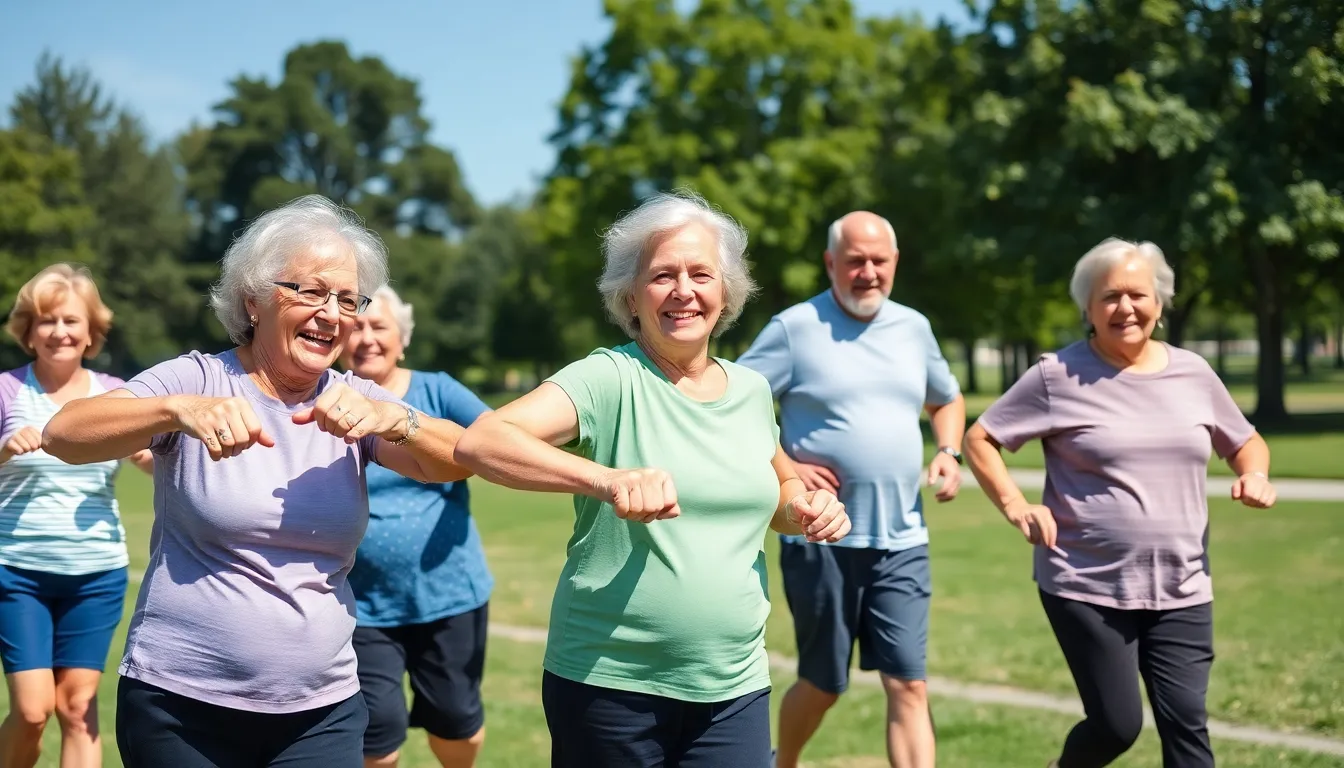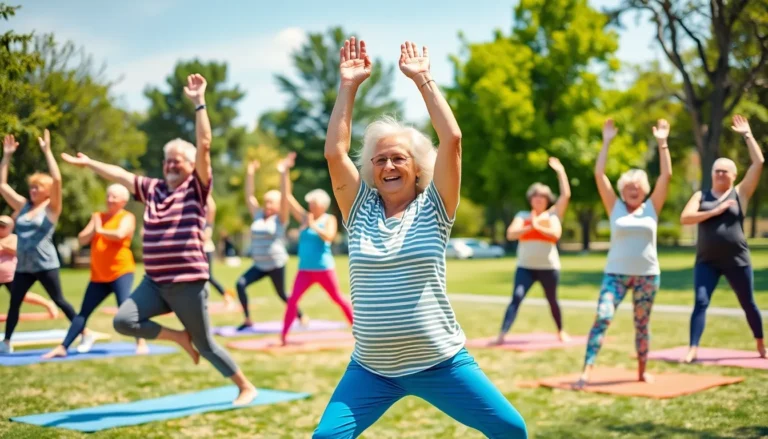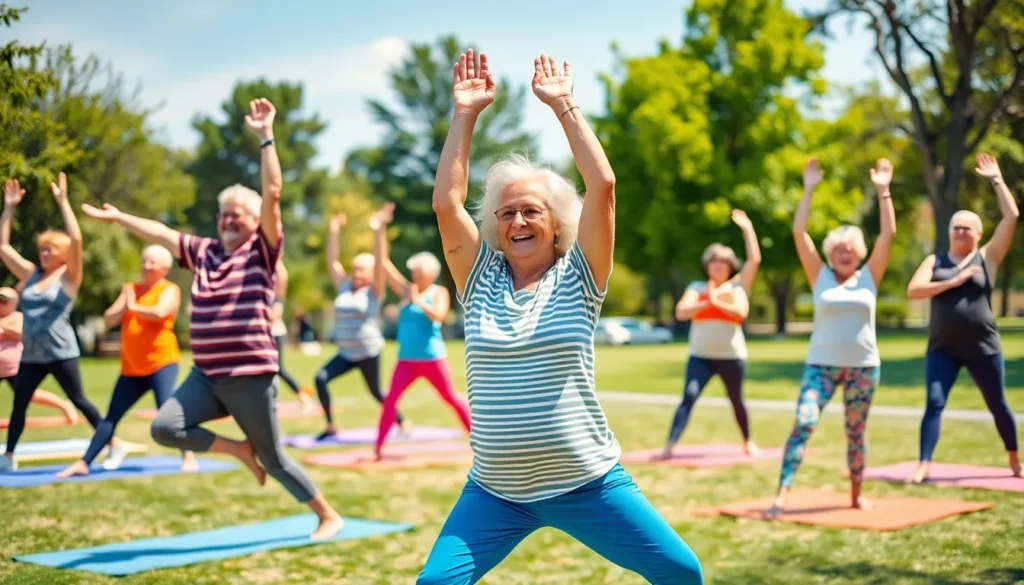Table of Contents
ToggleRetirement marks a significant transition in life, offering newfound freedom and opportunities for personal growth. However, staying active during this phase is crucial for maintaining physical health and mental well-being. Engaging in regular exercises not only combats the risks of aging but also enhances overall quality of life.
Incorporating tailored retirement exercises can help individuals build strength, improve flexibility, and boost cardiovascular health. From gentle yoga to brisk walking, the options are diverse and adaptable to various fitness levels. Embracing an active lifestyle in retirement can lead to a happier, healthier, and more fulfilling life, making it essential to explore the best exercise routines suited for this exciting new chapter.
What Are Retirement Exercises?
Retirement exercises involve physical activities specifically designed to accommodate the needs and limitations of older adults. These exercises focus on improving strength, balance, flexibility, and cardiovascular health. Tailored programs often include low-impact exercises, which minimize strain on joints while providing significant health benefits.
Common types of retirement exercises include:
- Walking
Walking is an accessible exercise that enhances cardiovascular health and promotes mental well-being. It can easily be adjusted to personal fitness levels.
- Yoga
Yoga improves flexibility and balance while reducing stress. Multiple forms exist, catering to different abilities and preferences.
- Chair Exercises
Chair exercises allow individuals with limited mobility to stay active. These movements strengthen muscles and promote circulation without the risk of falling.
- Strength Training
Strength training builds muscle mass and maintains bone density. Light weights or resistance bands can provide effective workouts.
- Swimming
Swimming offers a low-impact way to enhance cardiovascular fitness and joint mobility. Water supports the body, reducing strain during exercise.
Engaging in these activities not only aids in physical health but also fosters social connections and enhances mental health. It’s vital for retirees to consult healthcare professionals when planning their exercise routines, ensuring safety and suitability to their specific needs.
Benefits of Retirement Exercises

Retirement exercises offer numerous advantages that significantly enhance both physical and mental well-being. Fostering an active lifestyle during retirement contributes to long-term health and happiness.
Physical Health Benefits
Engaging in retirement exercises provides various physical health benefits:
- Strength Improvement: Regular strength training builds muscle mass, which declines with age.
- Balance Enhancement: Exercises focusing on balance reduce the risk of falls, a common concern for older adults.
- Flexibility Increase: Stretching routines improve flexibility, easing daily movements and reducing stiffness.
- Cardiovascular Health: Activities like walking or swimming enhance heart health, lowering the risk of cardiovascular diseases.
- Weight Management: Consistent physical activity aids in maintaining a healthy weight, preventing obesity-related issues.
- Chronic Disease Management: Exercise helps control conditions such as diabetes, hypertension, and arthritis, contributing to overall health.
Mental Health Benefits
Retirement exercises also significantly impact mental health:
- Stress Reduction: Physical activity promotes the release of endorphins, alleviating stress and anxiety levels.
- Mood Improvement: Regular exercise can reduce symptoms of depression, fostering a positive outlook on life.
- Cognitive Function Support: Engaging in physical activities can enhance memory and cognitive abilities, reducing the risk of dementia.
- Social Connections: Group exercises promote social interaction, combating feelings of loneliness and isolation.
- Sleep Quality Enhancement: Regular physical activity improves sleep patterns, contributing to better rest and overall well-being.
Retirement exercises encompass both physical and mental health benefits, making them essential for an active and fulfilling lifestyle.
Types of Retirement Exercises
Retirement exercises encompass various physical activities that cater to the unique needs of older adults. These activities aim to promote health, improve well-being, and enhance quality of life in retirement.
Low-Impact Aerobics
Low-impact aerobics offer a safe way to improve cardiovascular fitness without straining joints. This type of exercise includes activities like water aerobics, dancing, and cycling, all designed to raise heart rates while minimizing the risk of injury. Engaging in low-impact aerobics for 150 minutes weekly can lead to increased stamina, better energy levels, and improved overall health.
Strength Training
Strength training focuses on building and maintaining muscle mass, critical for countering age-related muscle loss. Utilizing resistance bands, light weights, or body-weight exercises enhances muscle strength and bone density. Performing strength training exercises two to three times weekly, targeting major muscle groups, provides significant benefits, including improved mobility, better posture, and greater independence in daily activities.
Flexibility and Balance Exercises
Flexibility and balance exercises help prevent falls, promoting stability and mobility. Activities such as yoga, tai chi, and simple stretching routines enhance flexibility while improving body awareness. Incorporating these exercises into a routine two to three times weekly can significantly increase range of motion, reduce stiffness, and contribute to overall balance, thus enhancing safety and confidence during movement.
Creating a Retirement Exercise Routine
Creating a retirement exercise routine involves establishing clear objectives and choosing enjoyable activities. A thoughtful approach promotes adherence and fosters a satisfying lifestyle.
Setting Goals
Setting goals is essential for a successful exercise routine. Specific, measurable, attainable, relevant, and time-bound (SMART) goals provide clarity and focus. For example, retirees might aim to walk 30 minutes five times a week, participate in a yoga class twice a week, or improve balance with targeted exercises. Regularly reviewing and adjusting goals helps maintain motivation and track progress.
Finding Activities You Enjoy
Finding enjoyable activities enhances consistency in an exercise routine. Retirees can assess their preferences by considering options such as walking, chair exercises, swimming, strength training, or dancing. Group classes or local community events also provide opportunities for social interaction while staying active. Engaging in hobbies like gardening or cycling further integrates physical activity into daily life, fostering a sustainable and fulfilling routine.
Staying active during retirement is more than just a choice; it’s a lifestyle that enhances overall well-being. Engaging in tailored exercises not only supports physical health but also nurtures mental clarity and social connections. By incorporating enjoyable activities into daily routines retirees can experience increased energy levels and improved quality of life.
Setting achievable fitness goals and exploring various exercises ensures that retirement remains a vibrant and fulfilling phase. With the right approach to exercise retirees can embrace this new chapter with confidence and vitality. Prioritizing health through movement paves the way for a happier and more independent retirement.







